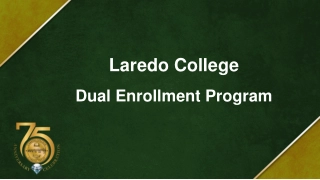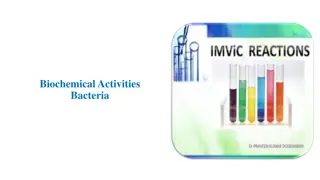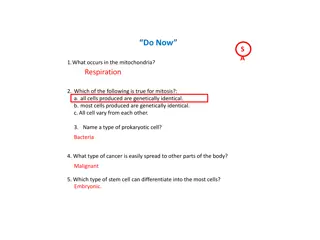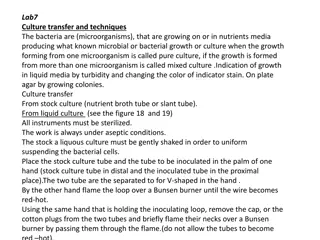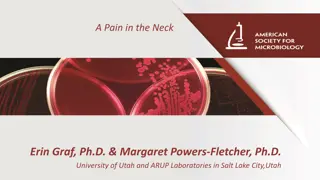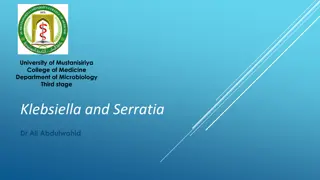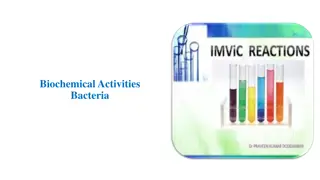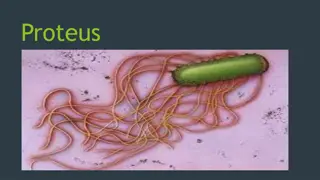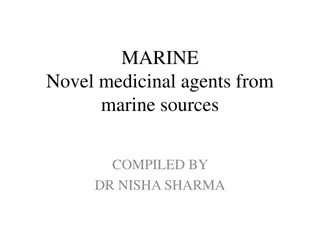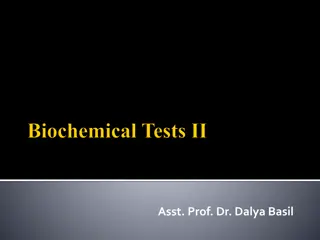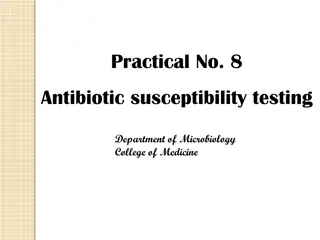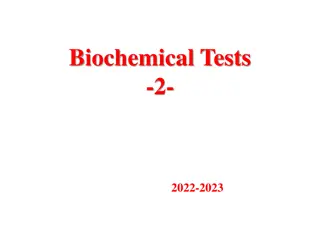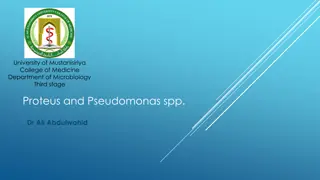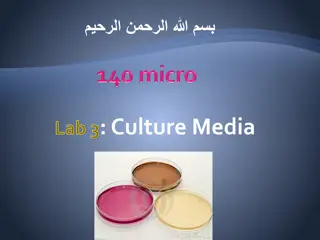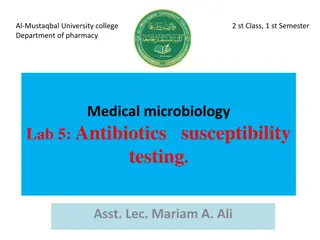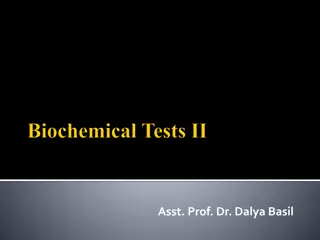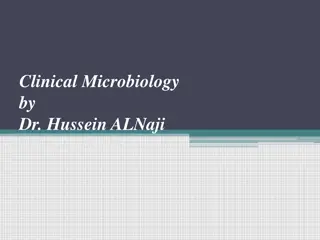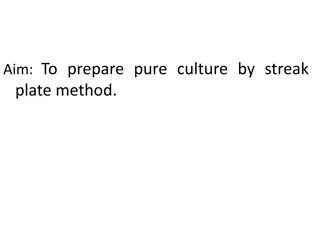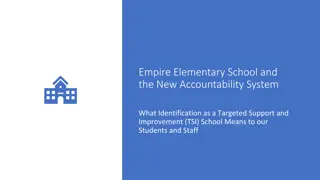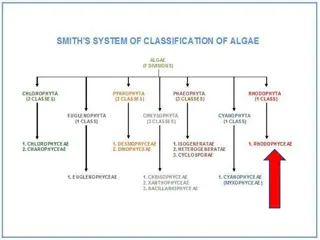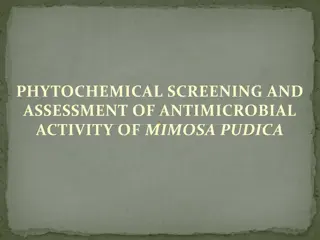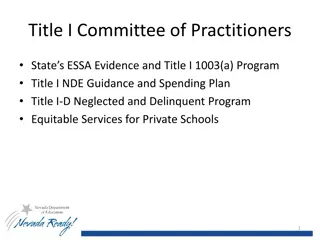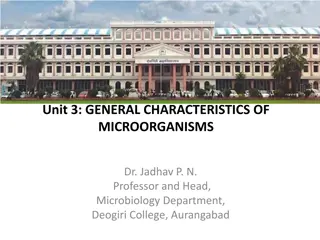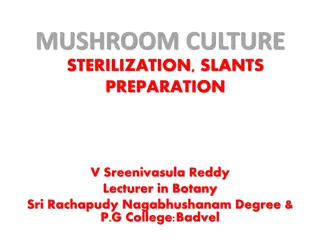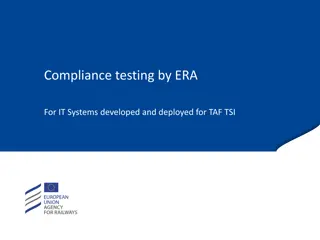Laredo College Dual Enrollment Program Information
Laredo College Dual Enrollment Program offers High School Students the opportunity to take College Courses through various programs like Dual Credit, Early College, and Early Enrollment. Students must meet specific criteria for enrollment, including TSI standards, course placement requirements, and
1 views • 13 slides
Bacterial Biochemical Identification Tests in Microbiology
Understand the significance of biochemical tests like the Triple Sugar Iron Agar Test (TSI) and the IMViC Test for identifying enteric bacteria. Learn about indole production, methyl red test, and other methods used in bacteriology.
5 views • 17 slides
Senior Update: Graduation Requirements, Endorsement Areas, Additional Testing
Senior Update provides essential information for Class of 2024 seniors, covering topics such as college visits, GPA exemptions, graduation requirements, missing credits, and more. It details the Foundation Plan and Distinguished Plan credit requirements, outlines various endorsement areas available
6 views • 19 slides
Dual Credit Options at Champion High School
Champion High School offers Advanced Placement (AP) and Dual Credit programs in partnership with various institutions like Northwest Vista College, Angelo State University, UT On-Ramps, and Tarleton Today. Students can earn college credit by meeting testing requirements, with some classes being free
1 views • 14 slides
Culture Media
Culture media play a crucial role in isolating bacteria from clinical specimens. Water, electrolytes, peptone, agar, meat extract, yeast extract, and blood/serum are essential constituents used in culture media. These components provide nutrients, solidifying agents, and growth factors necessary for
1 views • 26 slides
Safety Measures for Growing Microorganisms in the Laboratory
In the laboratory, it is crucial to use aseptic techniques when dealing with microorganisms to prevent contamination and ensure safe growth. Understanding the importance of agar plates, Petri dishes, and incubators in creating optimal conditions for microbial growth is essential. By following proper
0 views • 25 slides
Houston Community College Dual Credit Information
Dual credit program at Houston Community College allows high school students to earn college credits in core subjects. Requirements for eligibility include meeting TSI standards and specific test scores. Students need to apply to HCC, follow instructions for document submission, and meet deadlines f
0 views • 8 slides
Bacterial Culture Transfer Techniques and Growth Indicators
Bacterial cultures can be transferred using aseptic techniques to ensure purity. Growth indicators such as turbidity in liquid media and colonies on agar plates signify microbial growth. Proper sterilization and handling of instruments are crucial in the process. Techniques like streaking on agar pl
1 views • 4 slides
Understanding Anaerobic Infections: A Case Study in Clinical Microbiology
In this case study, two patients present with fever, neck pain, and previous misdiagnoses of viral pharyngitis. Blood cultures reveal anaerobic growth, with Gram stain showing pleomorphic Gram-negative rods. Anaerobic cultures require specialized conditions for growth, such as anaerobic glove box in
1 views • 14 slides
Understanding Antibiotic Susceptibility Testing Methods
Antibiotic susceptibility testing is crucial for determining effective antibiotics against bacterial infections. Common methods include Kirby-Bauer and agar disk diffusion, evaluating zones of inhibition to categorize susceptibility. Techniques involve seeding agar plates, placing antibiotic disks,
2 views • 17 slides
Klebsiella Species: Characteristics and Pathogenicity
Klebsiella species, such as K. pneumoniae and K. oxytoca, are gram-negative bacilli commonly found in the microbiota of the intestines, nasopharynx, and feces. They exhibit distinct characteristics like pink mucoid colonies on MacConkey's agar and are known to cause both community-acquired and hospi
0 views • 24 slides
Understanding Biochemical Tests for Bacterial Identification
Explore the importance of biochemical tests like Triple Sugar Iron Agar and IMViC in identifying enteric bacteria. Learn about indole production and the Methyl Red test, essential in distinguishing bacterial species based on their metabolic activities. Discover how these tests aid in diagnosing food
2 views • 17 slides
Understanding Proteus Bacteria: Historical Significance, Pathogenesis, and Laboratory Diagnosis
Proteus species, named after the Greek god Proteus, exhibit pleomorphism. Their historical importance stems from the unique characteristics of H and O antigens, with flagellated strains resembling a thin film on agar. Pathogenically, Proteus mirabilis and P. vulgaris are opportunistic pathogens caus
0 views • 12 slides
Marine Novel Medicinal Agents from Marine Sources Compiled by Dr. Nisha Sharma
Oceans, covering more than 70% of the Earth's surface, harbor a plethora of invertebrates and algal species, providing a rich source of medicinal compounds. Marine organisms have yielded commonly used drugs like shark and cod-liver oils, sodium alginate, agar-agar, and chitin. Various classification
1 views • 9 slides
Methods for Determination of Microbial Growth
Quantitative determination of microbial growth is crucial for various purposes, with two commonly used methods being the standard plate count and spectrophotometric measurement. The standard plate count method estimates living microbial cell density, while spectrophotometric measurement relies on tu
2 views • 6 slides
Understanding Triple Sugar Iron Agar (TSI Agar) Test
Triple Sugar Iron Agar (TSI Agar) is a differential media used for identifying gram-negative enteric bacilli based on carbohydrate fermentation and hydrogen sulfide production. It helps detect carbohydrate fermentation, gas production, acidification, and H2S formation, providing valuable information
1 views • 28 slides
Understanding Antibiotic Susceptibility Testing
Antibiotic susceptibility testing is crucial in determining the effectiveness of antibiotics against specific bacteria. The Kirby-Bauer method, a standardized paper disk agar diffusion method, is commonly used for this purpose. By observing zones of inhibition around antibiotic disks on agar plates,
1 views • 21 slides
Understanding the Triple Sugar Iron Test in Biochemical Analysis
The Triple Sugar Iron Test (TSI) is a crucial biochemical test used to differentiate gram-negative enteric bacilli based on their carbohydrate fermentation and hydrogen sulfide production. By examining color changes, gas production, and precipitate formation, microbiologists can interpret TSI result
2 views • 31 slides
Understanding Proteus Species: Morphology, Cultural Characteristics, and Antigenic Structure
Proteus species, specifically P. mirabilis and P. vulgaris, are important opportunistic pathogens in human infections. They exhibit unique characteristics such as swarming growth on agar, gram-negative coccobacilli morphology, and distinctive antigenic structures with O and H antigens. The swarming
2 views • 25 slides
Understanding Culture Media for Microorganisms
Culture media play a vital role in the growth and study of microorganisms. This content covers the primary ingredients required by all living organisms, types of culture media based on physical state, and specific media for bacteria and fungi. It explains the components and purposes of different typ
0 views • 24 slides
Building an Active Region Database for Solar Irradiance Variability Using SDO Images
San Fernando Observatory (SFO) at California State University Northridge is leveraging ground-based and space-based images to fill data gaps in solar images and develop a database for studying Total Solar Irradiance (TSI) variability. By extracting active-region information from Solar Dynamics Obser
5 views • 21 slides
Understanding Bacterial Colony Morphology for Microbiology Analysis
Bacterial colonial morphology plays a crucial role in identifying bacteria and fungi. This exercise focuses on recognizing the cultural characteristics of bacteria on agar plates through colony morphology. Each colony represents a genetically similar group of microorganisms derived from a single cel
1 views • 6 slides
Understanding Antibiotic Susceptibility Testing in Medical Microbiology Lab
Antibiotics are chemical substances produced by microorganisms to inhibit or kill other microorganisms. In the lab, antibiotics susceptibility testing is conducted using the Disc Diffusion method (Kirby-Bauer method) on agar plates. The sensitivity of bacteria to antibiotics is determined by measuri
0 views • 11 slides
Understanding Triple Sugar Iron Agar (TSI Agar) Test in Microbiology
Gain insights into the Triple Sugar Iron Agar (TSI Agar) test used for differentiating gram-negative enteric bacilli based on carbohydrate fermentation and hydrogen sulfide production. Learn about detecting carbohydrate fermentation, interpreting results, and performing the test accurately with deta
0 views • 28 slides
Class of 2016 Senior To-Do List - Elkins HS
The Class of 2016 Senior To-Do List from Elkins High School includes important tasks such as meeting graduation requirements, preparing for College Ready criteria, ensuring name on lists for events like Decision Day, and understanding the significance of the TSI Assessment. Seniors are encouraged to
0 views • 12 slides
Understanding Selective and Differential Media in Clinical Microbiology
Mannitol Salt Agar, MacConkey's Agar, Eosin Methylene Blue Agar, and Salmonella Shigella Agar are crucial tools in clinical microbiology for isolating and identifying specific bacteria. These selective and differential media help differentiate between different strains based on their ability to ferm
0 views • 13 slides
Pure Culture Preparation by Streak Plate Method
Bacteria often exist in mixed populations, making it essential to isolate them for studying their characteristics. The streak plate method, involving streaking nutrient agar and incubating, helps in obtaining pure cultures of individual species. This method facilitates the observation of isolated co
0 views • 5 slides
School Performance and Improvement Insights at Cold Springs MS
Discover the targeted support and improvement initiatives at Cold Springs MS for the academic years 2020-21. Explore how schools in Nevada are rated based on academic achievement, language proficiency, student engagement, growth, and opportunity gap closure. Understand the criteria for determining s
0 views • 10 slides
Understanding Empire Elementary School's Targeted Support and Improvement (TSI) Identification
Empire Elementary School delves into the implications of being identified as a Targeted Support and Improvement (TSI) school under the new accountability system. The presentation explores the reasons for the updated accountability system in New York, the impact of ESSA funding on student programs, t
0 views • 24 slides
Overview of Telematics Applications for Passengers (TAP TSI) in European Rail Legislation
This presentation on Telematics Applications for Passengers (TAP TSI) in the UK industry meeting highlights the legal framework, functionalities, jargon used, and European rail legislation. It covers standards, technical specifications, abbreviations, and European legal documents governing passenger
0 views • 20 slides
Main Characteristics of Rhodophyta: The Red Algae Division
Rhodophyta, or red algae, are mostly marine algae with distinct photosynthetic pigments giving them a red color. Their main characteristics include the presence of phycoerythrin pigment, floridean starch as food reserve, thalloid plant body structure, oogamous sexual reproduction, and cell walls con
0 views • 27 slides
Kentucky Department of Education School Improvement Efforts
The Kentucky Department of Education focuses on school improvement efforts through Comprehensive Support and Improvement (CSI), Targeted Support and Improvement (TSI), and Additional Targeted Support and Improvement (ATSI) programs. Schools undergo a statutory and regulatory process as per state law
0 views • 7 slides
Microbial Isolation Techniques and Methods
This content provides a detailed guide on the isolation of microbes from various environments using techniques such as sample introduction, inoculation, incubation, inspection, and identification. It includes information on the use of an incubator, materials, and methods required for microbial isola
0 views • 13 slides
Phytochemical Screening and Antimicrobial Assessment of Mimosa pudica
This study explores the antimicrobial potential of Mimosa pudica extracts through phytochemical screening. Researchers investigated the leaves' antimicrobial characteristics and screened for phytochemical compositions to understand their effects on various microorganisms. The methodology involved sa
0 views • 18 slides
Title I Committee of Practitioners & ESSA Evidence Program Overview
In this overview, Gabby Pingue, the Title I Programs Director, discusses the importance of evidence-based interventions and activities in improving student outcomes under Title I programs. The ESSA evidence levels 1-4 are explained, highlighting the criteria for each level. The focus is on supportin
0 views • 22 slides
Exploring the Fascinating World of Algae: Characteristics, Types, and Applications
Delve into the intriguing realm of algae, from their general characteristics to the various types such as Diatoms, Green Algae, Blue-Green Algae, Yellow-Green Algae, and Red Algae. Algae range from microscopic to seaweed, serving as autotrophic organisms with reproductive structures like gametangia.
0 views • 16 slides
Mushroom Culture Sterilization and Slants Preparation Methods
Learn about the sterilization methods for glassware, agar medium, and culture medium in mushroom culture. Understand the preparation of agar slants and culture slants to maintain a sterile environment for successful cultivation. Follow detailed procedures for sterilization at different levels in the
0 views • 17 slides
Understanding Dual Credit Education and Eligibility Criteria
Dual credit programs allow high school students to earn college credits while still in high school, providing numerous benefits such as cost savings, weighted GPA benefits, and a smoother transition to college. Eligibility for dual credit courses is typically based on meeting criteria such as TSI sc
0 views • 16 slides
South Plains College 2020 Administrator & Adjunct Updates on TSI Changes
South Plains College 2020 Administrator & Adjunct Updates highlight changes in TSI requirements, dual credit eligibility, and the launch of TSIA 2.0. The updates address COVID-19 responses, college readiness, required scores, and dual credit credentialing criteria. For more information, contact Ryan
0 views • 35 slides
Compliance Testing by ERA for IT Systems Developed and Deployed for TAF TSI
Compliance testing for IT systems developed and deployed for TAF TSI involves checking if messages comply with TAF XSD and basic parameters, assessing compliance of IT tools against TSI requirements, and issuing compliance assessment reports. The process includes testing messages for mandatory eleme
0 views • 4 slides
